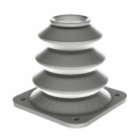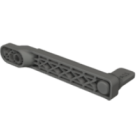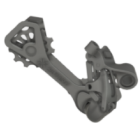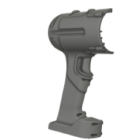Binder Jetting
While many 3D printing technologies rely on heat, lasers, or UV light to solidify material, Binder Jetting takes a completely different approach. It’s one of the few additive manufacturing processes that decouples the printing phase from the fusing phase, allowing for faster throughput, lower energy use, and large-scale batch production. From full-color concept models to functional metal components, Binder Jetting is quietly reshaping how industries think about additive manufacturing — especially in terms of scalability and cost-efficiency.
What is Binder Jetting?
Binder Jetting is an additive manufacturing process in which a liquid binding agent is selectively deposited onto a powder bed to bond particles together — layer by layer — until a part is complete. Unlike many other powder-based 3D printing methods (like SLS or SLM), Binder Jetting doesn’t rely on high temperatures or lasers to fuse materials. Instead, the solidification occurs chemically, with the binding liquid acting as the “glue” between powder particles.
This makes it fundamentally different from technologies like Material Jetting, which jet photopolymers that are cured by UV light, or SLM/DMLS, which fully melt metal powders using a laser.
How does the Binder Jetting process work?
The process starts with a thin layer of powder (metal, sand, or ceramic) spread across a build platform. A print head, similar to those in inkjet printers, moves across the layer, selectively depositing Binder where the part should solidify. Once one layer is complete, the platform lowers, a new layer of powder is spread, and the process repeats.
After printing, parts are in a fragile “green state” and require post-processing. For metals, this typically includes curing, debinding, and sintering in a furnace, where the powder particles fuse without fully melting. In the case of sand molds or ceramic components, curing alone may suffice.
Binder Jetting materials
This technology supports a broad range of materials, depending on the intended application. Common categories include:
- metals: stainless steel, Inconel, copper, titanium,
- ceramics: silica, alumina,
- sands: used in foundry cores and molds,
- composites or color sandstone: used in full-color models or low-strength prototypes.
Notably, metal Binder Jetting has gained momentum in industries aiming for high-throughput, low-cost part production without the complexity of lasers or closed-loop systems.
Advantages and disadvantages of Binder Jetting
Key advantages
| Considerations
|
Binder Jetting vs. Material Jetting
Despite similar names, Binder Jetting and Material Jetting are completely different. Material Jetting is more like photopolymer 2D printing — it jets droplets of liquid resin that are UV-cured layer by layer. It’s ideal for smooth-surfaced prototypes and visual models, not industrial-strength parts.
Binder Jetting, on the other hand, uses powder as its raw material and can produce robust metal or ceramic parts after sintering. It’s much closer to powder bed fusion technologies in terms of application.
Where Binder Jetting shines
Binder Jetting is a go-to technology when cost, speed, and scalability matter more than surface perfection or isotropic strength. It’s widely used for:
- metal parts in low to mid-volume production,
- casting molds and cores in the foundry industry,
- full-color concept models,
- architectural or artistic ceramic elements,
- rapid tooling or fixtures.
Its ability to separate printing from sintering opens up the opportunity for batch-level post-processing, which can be more efficient in production workflows compared to layer-fusion systems.
Metal Binder Jetting vs DMLS/SLM
Binder Jetting and DMLS/SLM both target metal part production, but they follow very different paths. DMLS and SLM fully melt powder using a laser, resulting in parts that are nearly identical to forged components — dense and very strong — but also expensive and slow.
Metal Binder Jetting skips the laser and instead sinters parts after printing. This typically results in lower density but enables much faster throughput and lower costs, making it ideal for high-volume applications where some compromise in mechanical properties is acceptable.
Summary
Binder Jetting is a unique and versatile 3D printing technology that excels in speed, scalability, and cost-efficiency, especially for metals and ceramics. While it does come with post-processing challenges, its ability to produce functional parts in batches — without the need for high-energy lasers or complex support removal — makes it an attractive option for production-focused industries. From full-color prototypes to castable sand molds to metal fixtures, Binder Jetting plays a strategic role in the broader additive manufacturing landscape.
Explore also
- Overview of 3D printing tech
- What is SLS printing?
- What is FDM 3D printing?
- What is SLA 3D printing?
- MJF 3D printing
- DLP 3D printing
- What is DMLS and SLM 3D printing?
- Material Jetting
- PolyJet printing
- New 3D printing technology
- 3D print vs injection molding
Related categories













